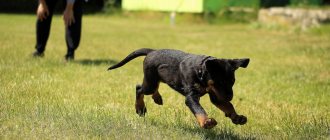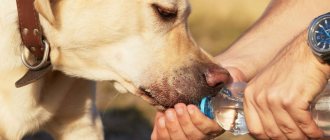A dog is a social, highly organized animal with a complex psyche. She absolutely needs to walk outside in order not only to perform her natural needs, but also to receive a variety of impressions, so it is normal for the dog to run away. A free-ranging dog releases pent-up energy by running and playing with the owner, satisfies the hunger for communication with someone other than the owner’s family, gets the opportunity to “exchange” marks with other dogs and meet people, dogs, cats and other animals, gets an introduction about the world outside her home, receives a portion of fresh air and sunlight necessary for normal metabolism, grinds her claws down naturally, and learns not to react to irritants.
Without this, the animal becomes nervous, fearful, aggressive, displays undesirable behavior on the street: the dog tries to run away from the owner, breaks the leash, picks it up from the ground, barks for no apparent reason, shows aggression towards animals and/or people, in a word, behaves unacceptable. At home, such a dog acts as a true tyrant - he steals food, snarls, bites owners and guests, chews things, climbs on the bed even when it is forbidden to do so, ignores the place of the toilet and shits anywhere, constantly barks and howls, spoils things.
Why does a dog run away from its owner?
A properly raised dog must obey its owner unquestioningly and follow all commands. Disobedience can lead to dangerous consequences, for example, running away while walking. Such a problem is fraught with the loss of your four-legged friend; on the street he can get hit by a car or be bitten by other animals. There are several reasons why a pet regularly runs away from its owner:
- fear of punishment, regular abuse;
- banal disobedience - the dog is not trained in the “come to me” command;
- physiological needs, for example, the period of estrus;
- insufficient physical activity.
There are often situations when the owner is not the first owner of the dog or the animal is in foster care. This can lead to the pet trying to escape at any opportunity.
If a dog runs off its leash, it can only return if there is a strong emotional connection with its owner. Thanks to physical endurance, the animal can go quite a long distance, but thanks to marks and familiar smells in its area, the pet can find its way back. However, it is recommended to begin search activities immediately to avoid unpleasant consequences.
Photo: flickr.com
Underwater rocks
By testing the outside world to its teeth, the puppy actively learns to interact with it and develops adequate behavioral reactions. He spends all his energy on this and therefore needs support. In a complex and sometimes dangerous environment, he needs a zone of safety and comfort where he can hide. In the still unknown world, the puppy is afraid of losing those who create this “island of safety” for him - his fellow tribesmen or the owners who replace them. But you shouldn’t leave things to chance, hoping that his “obedience” will naturally develop into the upbringing of an adult dog, because at this time the dog is not so much obedient as dependent.
What do the owners care about at this time? They discuss vitamins, vaccines, food from various companies and... ignore raising the puppy - why, because there are no behavioral problems now. Only then, much later, are the first steps taken to train the dog, which are necessarily associated with breaking, alas, already established behavior. Of course, it is naive to believe that there is a panacea for the “teenage rebellion” of a young dog, but there is an emollient provided by nature itself.
The fact is that in the first months of life, the environment greatly influences the animal’s innate behavioral programs, on which its behavior and how it will communicate with its human partner will depend. Try not to destroy the puppy’s initial trust in the older “members of the pack” with your behavior - it makes him perceive the owner as an ally, and not as an adversary whom he wants to resist. This will allow you to overcome difficult periods with minimal losses.
Take advantage of the Internet
How to find a lost dog? You have access to the Internet! This is the most effective way of informing. Literally from the first minutes of your search, publish a message on social networks that your dog is missing. Ask your friends to make this post go viral. Let it go through all possible distribution channels to reach as many people as possible.
Go to special dog groups on social networks and publish your message in them.
Ask people for help so that they can let you know if someone spots your dog on the street.
Involve not only social networks, but also the websites of your city. Especially specialized ones dedicated to the sale and search of animals.
Monitor online advertisements for dogs for sale when you suspect your pet has been stolen.
Information spreads fastest on the Internet. Therefore, the chances that your friends from Facebook, OK or VK will help you are much higher!
Stop action
Ideally, your dog will run towards you. But this requires him to stop and change route, which can be difficult. For a simpler approach, encourage him to stop and lie down.
One of the best skills to learn is to lie down quickly. It is easier for a dog to fall than to turn around and run towards a person.
Therefore, teach your dog the “LIE” command in advance.
In fact, you can sit down and then pretend that you are playing with a toy to entice your dog to come take a look.
If the dog runs away while walking
Most often, dogs run away during a walk. This can happen regardless of age, gender or breed. The main reasons why pets run away while walking:
- The owner does not use a leash or tape measure - this is especially dangerous if the animal does not comply with the command “come to me” or “near”. According to the law of the Russian Federation, walking dogs is allowed only on a leash, the length of which allows you to control the pet’s behavior.
- Dogs are sensitive to the mood and emotions of their owner. She may consciously run away if you call her with a threatening intonation, irritation and aggression in your voice.
- Punishing the pet by any means if it nevertheless approaches the leg after escaping. In this case, the animal will form a clear behavioral connection - “punishment for obedience.” This can lead to the pet stopping following commands altogether.
- The dog picks up something and then runs away to avoid punishment. Having a muzzle will help avoid this situation.
- The owner begins to run after the dog if it does not approach on its own. It is best to call her with loud sounds, move calmly and confidently. To attract attention, you can suddenly change the trajectory of your movement, sit down or start jumping.
- The dog's passion for something. It is especially common among hunting breeds and male dogs that have found the trail of a female dog in heat. In this case, you should first draw attention to yourself, and only then call.
- The dog is afraid of his owner. An animal will not want to approach a person who treats it aggressively and regularly punishes it with physical force.
If your four-legged friend does come to you when called, you should not scold or reprimand him, or immediately take him home. The dog develops a bond that the walk ends when he returns. You should also remember about stable physical activity - if the dog does not splash out energy, its obedience and reaction to the owner worsen.
Teaching the dog the “Come to me” command
The dog, regardless of breed, must be trained and clearly follow basic commands, such as: “Near”, Fu”, “No”, “Place”, “Come”. Not all dogs make ideal students, especially those with inexperienced owners.
Advice! If you do not have animal training skills, you have your first dog, or your pet is very disobedient, seek help from a dog trainer. The specialist will find an approach to the dog and select the optimal training system.
We teach the dog the “Come to me” command:
- We conduct the first lessons on a long canvas leash. For large dogs, you can also use a strict collar during classes.
- As soon as the pet is a short distance from you, after a few seconds say the pet’s name and give the command in a strict, confident intonation.
- If the dog does not respond, pull the leash towards you.
- You can attract your dog's attention with a treat. As soon as the dog approaches, praise him and give him a treat. Always give your dog different treats. Alternate treats with rewards.
- In the future, replace the treat with praise so that the animal does not constantly associate the call with food.
- Once the dog begins to understand and follow the “come to me” command, begin training without a leash.
- Practice the command in different places and situations.
During your walk, repeat the command “Come to me” several times. Always praise your dog for doing the right thing. When the dog is walking without a leash and runs towards you, give the command “Come to me” several times during the walk.
Do not give a command when your pet is very passionate about something, especially in the first lessons. The dog must be focused on the training process. Attract the dog with a nickname, a treat, pull the leash, and when the dog looks in your direction or walks towards you, say a command in a clear intonation.
Important! The “Come to me” command should not be associated with punishment or something unpleasant for the pet. For example, do not call your dog if you are planning to cut its nails, clean its ears, or perform other hygienic or medical procedures that are not very pleasant for the pet.
Knowing the “Come to me” command, if the dog follows it unquestioningly, you don’t have to worry about the safety of your pet.
Fear
First you need to determine whether the animal is doing this out of its own fear. Perhaps something is frightening the dog, so it is trying to hide. In addition, animals often react too strongly to unfamiliar noises. Perhaps there is construction work going on in a neighboring area and your pet is simply scared. He may also be afraid of various visual images, such as flashes of bright lights or strangers walking on the sidewalk past your house.
First things first: don't chase the dog.
It may go against all your instincts, but it is important not to chase a running dog. With very few exceptions, most of us can't keep up with our four-legged friends.
If your dog is afraid, you won't catch him, and if he thinks he's playing a game, you'll only make things worse.
Instead, it is recommended to turn the game in the opposite direction - into a chase and convince the dog to run after you. Getting your dog to chase you can be fun for the dog. Try running around with a toy or treat, or even getting in the car if your dog likes to travel.
If the dog runs away from the yard
In a private home or country house, dogs are often placed outside in an enclosure, on a chain. Even a well-bred and trained animal can run away when exposed to certain external factors. The main reasons why a dog runs away from the site:
- Fear. Pets have a sensitive psyche and are often afraid of sharp sounds - thunder, car horns or pyrotechnic explosions. In such situations, they begin to behave restlessly, which leads to atypical behavior.
- Boredom. For example, if the owner is away from home for a long time. As a rule, this happens with close emotional contact and good socialization of the pet. Escapes often occur due to boredom and with insufficient physical activity.
- Curiosity. The animal may become interested in something outside the yard. It could be a passerby with food or a pleasant smell, a passing cat, or another dog. In such a situation, the pet begins to dig a tunnel and tries to jump over the fence.
To avoid your four-legged friend escaping from the yard, you need to provide maximum protection and isolation from the outside world. Most dogs run away through the fence - they dig under it or jump over it, crawling through holes. It is necessary to ensure reliable protection of the territory and regularly check its integrity.
Most often, representatives of hunting breeds escape (they love to dig, do it efficiently and quickly), as well as large animals capable of high jumps.
Regardless of the size of the breed, it is recommended to tie the dog when you leave home. A securely fastened chain is suitable for this purpose, since the rope can be easily chewed. You should pay attention to the convenience and reliability of the collar - it should fit snugly to the neck and be comfortable for the pet.
The length of the leash should be sufficient for free access to the enclosure or booth, bowls of food, and water. Tangling the legs is strictly prohibited - this method is used only for cattle and horses in the stall.
Add some brains!
So, did you feel like your puppy was running away out of idle curiosity? Now you understand that he is doing important work - learning about the world around him and himself in it in order to become a full-fledged adult dog. After all, it is not enough to have good heredity, it is not enough to belong to a glorious galaxy of certified ancestors - we must make the biological inheritance contained in the genes work. This requires personal experience of encountering the diversity and complexity of the external environment, with its mysteries and dangers. The puppy needs to try and hone his natural abilities in order to develop correctly. You need to experience anxiety and stress, waste energy and get tired.
There was no limit to my amazement when one day, while walking my dog, I met a woman in the park with a 4-month-old husky on a leash. The shepherd wanted to approach the puppy because she loved to play with the “young people.” Seeing this, the woman frantically pulled on the leash and began to retreat, nervously demanding that I take the dog. The owner explained to me that “the puppy is still too small for such games!” Having met this couple six months later, I was not surprised to hear complaints about the dog’s behavior: it ran away from its owner and behaved aggressively when on a leash, although it was afraid of large dogs.
People are willing to pay for a rare breed or for the puppy to come from titled parents. Convinced that the money spent guarantees the “quality” of the dog, they often begin to spoil the precious puppy, not giving it the opportunity to develop properly. It seems that the practice of keeping a dog in an apartment without walking it for up to 4-5 months is already becoming a thing of the past. However, when starting to walk with a 2-3 month old puppy, people overprotect the baby, not allowing him to fully get acquainted with the world: they do not let him off the leash, regulate his relationships with his relatives, or walk in the same place all the time. It is not surprising that the dog seeks to escape such control.
You shouldn’t waste time waiting for the training grounds to start enrolling in obedience schools. You can work with a dog from two months old, and the owner himself is an excellent tool for developing the puppy’s intelligence. Give food to his mind in the form of educational games with family members, communication with peers and adult dogs, walks along crowded streets and through the forest. Of course, following this style of relationship with a puppy can waste a lot of time and effort, but it will be a very interesting and creative time! By stimulating and strengthening the puppy’s psyche through interaction with a complex environment, a person can literally “grow” his dog’s brains, which will help him grow resistant to any external influences. Add to this the dog’s complete trust in its owner - after all, he has gone through this difficult path of mastering the world around him. Agree, this is probably what many people dream about when they get a companion dog.
Elena Neprintseva
If the dog runs away from home
In certain circumstances, a dog can easily run away from home. The most common reasons for running away:
- long absence of the owner;
- the presence of an open window, a balcony on the lower floors of the apartment;
- congenital or acquired fearfulness of the pet;
- sharp sounds outside the house;
- the presence of extraneous irritants - odors, animals running nearby, distracting passers-by.
If the dog is in foster care or has a previous owner, the animal may try to run away to find its previous home. If you are adopting an adult pet, it is important to build a good relationship and walk it well. Basic ways to prevent running away from home:
- securely close windows and front doors;
- ensure good physical activity, quality walking of the pet;
- leave a treat so that the animal has something to do;
- if a thunderstorm or fireworks explosions are planned (for the New Year), it is recommended to lock the animal in a small room without windows.
Treats can be hidden around the apartment to keep your pet interested while you are away. Various bones are effective, requiring a lot of time to crack them. After your return, your four-legged friend should always be rewarded for good behavior. Being alone should be taken calmly; the dog must be accustomed to this from puppyhood - left alone in the house, gradually increasing the duration.
The dog pesters guests
Another problem in animal behavior is that the dog pesters guests. There are two main undesirable options for a dog's relationship with guests. The first is a manifestation of aggression (explicit claims to leadership), the second is excessive friendliness, even to the point of permissiveness (increased affection).
In any case, you need to raise your status as a leader and every time make it clear to the dog that it is you who decide who can come into the house and who cannot. Resolutely stop the dog’s unwanted behavior with prohibiting (“No!”, “You can’t!”) or restraining (“Sit!”, “Lie down!”) commands.
How to find a dog?
If the pet does run away, search efforts should begin as early as possible. Useful tips:
- First of all, walk along the usual walking route, looking into all secluded places - basements, trash cans and bushes.
- While searching, take your favorite squeaking toy with you to attract attention with sound.
- Write an ad and post it in the area of the loss. It is best to use bright paper and attach a photo and description of the pet. It is advisable to place it on porches, poles, as well as in the nearest veterinary clinic and pet store.
- Post an ad on social networks, for example, in a thematic group in your city. Offer a reward, but do not indicate its amount (resale may be more profitable than the offered reward).
- If the dog has just run away in an unknown direction, ask passers-by.
- Before entering the house or near the entrance, leave your item with a scent so that it is easier for the dog to find the trail back.
- View video camera recordings in the city - some providers place video surveillance in courtyards, near city attractions and provide access to them for free.
- Call all city shelters, veterinary clinics and crematoriums for animals.
You should approach writing your ad wisely. It is not recommended to indicate all signs - this can protect you from scammers and accurately determine the signs of your pet during a call. You should not indicate the nickname, as this will help the dog adapt faster to its new owners.
Be sure to place an address tag on the collar indicating contact numbers and some emotional phrase, for example, “they are waiting for me at home.” The search for a runaway pet can continue for quite a long time; do not become discouraged if there are no results for a long period. The dog can run very far from home, starting from the second week, the search can begin in nearby cities.
Photo: flickr.com
What to do? How to fix?
First, castration or sterilization reduces the tendency to wander. This is especially true for cables. A medical procedure, preferably at an early age, will eliminate hormonal manifestations: wandering in search of a partner or the desire to assert one’s territory. Sterilized dogs relieve themselves less often in the house, are less aggressive, and are not prone to fights.
Secondly, it is necessary to set limits, creating an invisible barrier at every threshold. To do this, owners must position rapids as their property, training dogs so that they do not cross them without permission.
The best time for such training is the beginning of several daily walks. Firstly, the dog must be in a calm, obedient state and sit quietly before you put a leash on it. Then lead the dog to the door and open it, but do not allow him to leave. Make the dog sit at the doorstep and wait. You go out first. The dog is not allowed to follow you until you give a clear, unambiguous command. When returning home, repeat the procedure in reverse order. Open the door, but do not allow the dog to enter first. Do this on every walk and always vary the amount of time you make your dog wait before entering or exiting. Especially at first, wait until the dog stops making even the slightest attempts to move, concentrating his attention on you.
During the walk itself, keep your dog close to you, using a short leash to keep its head elevated at all times. Don't let her sniff or explore anything during the first part of the walk. You walk forward, and the dog walks with you. Once your dog has learned to walk alongside you without pulling on the leash, you can reward him by allowing him to quickly sniff something on the ground, and then continue walking forward, keeping the dog close.
You should also set limits when walking, especially before crossing a road. Stop at an intersection and make the dog stop so that it comes to a calm, obedient state, or even better, sits down. The dog is not allowed to cross the road until you say so; it can follow you only when you start moving. You may not be able to explain the limit to your dog right away, but if you consistently do the same thing every time you cross the road, eventually the dog will begin to stop before you tell it to, recognizing the limit you have set.
In parallel with setting these restrictions, you should also work on the “come to me” command. This will help reduce your dog's tendency to turn running away into a game of “catch me if you can.” To practice the “come” command, use a long leash. move as far away from the dog as possible, call it, move away again and repeat the procedure. When she returns to you on command, reward her with a treat or affection.
While it is second nature for a dog to wait before leaving the house, waiting before entering the house will take work. You can use a long leash for this exercise. Make your dog sit at the door and then move away. If the dog moves away, correct it and force it back. Continue until the dog stops trying to move. As a rule, having understood what they want from it, the dog calmly lies down in the indicated place.
Work on anticipation at every opportunity. if you are taking your dog to an unfamiliar place with a door or gate, make him wait. Do the same with cars, allowing your dog to get in or out of them only with your permission.
If you're worried about your dog running away, invest in a GPS tracking device. It is worn like a collar: you can track your dog's movements wirelessly. If the dog leaves the designated area, the device will turn on and send a signal about its location to your smartphone or computer.
Dogs are pack animals with a territorial instinct and are not naturally inclined to run away from home. However, without the proper challenge, discipline, mental stimulation and rules, a dog may simply run away from boredom, looking for something more interesting somewhere else. If you meet your dog's needs and make sure he is balanced and content, he will have no reason to run away. Create rules and restrictions regarding entry and exit from the house, and the dog will be much less willing to use an open door.
Install a dog house
To make your dog feel comfortable in the yard, equip him with a good kennel. Make sure your friend can wear it to protect themselves from rainy weather or the sun. If you are not sure which booth is needed for your breed, consult a pet store. Also, don’t be surprised if your pet avoids her at first. Typically, dogs need time to get used to their new home. Help her do this with the help of familiar toys, soft bedding and your things.
Reproductive instinct
There is a chance that your pet is running away from the backyard in search of a dog of the opposite sex. After the animal is six months old, its reproductive instincts begin to turn on. Male dogs are more likely to leave the house as soon as they smell a female.
Serebryakov returned to Russia. Shukshina believes that he should not have left
They wanted to clear the roof of snow and almost ended up under it: video
Many lines and two branches: we read the marriage lines under the little finger
How to stop a dog from running away
There are several methods to teach a dog not to run away from its owner during a walk in the yard. Basic Rules:
- Teach your pet the “come to me” command. This is recommended to be done in early childhood, when the opportunity arises for walks on the street. You need to call in a joyful and cheerful tone, reinforce the result with treats and encouragement. It is forbidden to scold an animal even if it disobeys. The main goal is to teach how to come to the leg after repeating the command once.
- Designate places on the site where the pet can walk freely. Select a place for the enclosure and insulate it if necessary. Place bowls of water and food nearby.
- From puppyhood, teach the animal to tolerate loneliness. Gradually increase the time when the dog is alone. You can leave the camera at home to monitor behavior.
- When walking, use a comfortable collar; the length of the leash should be sufficient for comfortable movement and your control.
If your dog regularly tries to run away during walks, then you need to take a full course of OKD. This will help teach your pet basic commands; a professional dog trainer will suggest patterns of behavior with a disobedient pet.
In what cases will you need professional help?
Unfortunately, even with experience with dogs and knowing the basics of training, it is not always possible to raise a puppy into an obedient, fully controllable dog. Therefore, if you cannot cope with your pet, you have a dog of a fighting breed, a service breed, a canine specialist will help you instill the necessary behavioral skills.
In what cases will you need professional help:
- If you have no experience in dealing with animals.
- The dog is uncontrollable, reacts inadequately to stimuli, behaves poorly at home and on walks.
- If behavior correction is necessary in case of errors in upbringing.
- The dog shows aggression towards people and animals.
- The dog constantly runs away from his owner on the street and does not respond to commands.
- Against the backdrop of stress and severe emotional shock, the dog’s behavior has changed dramatically, and you don’t know what to do with your pet.
The help of an animal psychologist or dog handler may be needed if you adopted an adult dog from a shelter or took responsibility for the life of a homeless animal.
Remember: you can do more
Today, running with a dog is reaching a professional level. There are canicross (not an ordinary jogging, but a sports discipline with its own championship) and special starts (the dog marathon in Peru, for example).
Cases when a pet and owner ran a half marathon together are also not uncommon. Try it too. Just remember that an athlete dog requires proper nutrition (use specially formulated sports food and energy supplements) and special care (regularly do an ECG, heart echogram and blood biochemistry, and also check joints).
Briefly about the main thing
- A dog may run away from its owner during walks, from the yard or directly from the house.
- The main reasons for running away are fear, external stimuli, boredom and lack of physical activity.
- If she lives in the yard, the area needs to be fenced off, and the holes and the presence of tunnels in the ground must be checked.
- If you need to leave your pet alone at home for a long time, it is recommended to leave a treat. Close windows, balconies and doors securely.
- To prevent your friend from escaping, it is important to teach him the “come to me” command and use a leash while walking.
- The search for a runaway dog can take a long time. Ads should be placed in nearby areas on social networks. Regularly go through your pet’s usual route.
Did your dog run away? Share your experience in the comment section on how you taught your pet to return on command.
Causes
As with many other behavioral problems in dogs, the reasons for running away from their home are rooted in a lack of leadership and mental stimulation, plus an excess of energy. Unlike people going to work or school and leaving their dogs at home, it is highly unnatural for relationships in nature for one or more members of the pack to leave the others and wander around the neighborhood alone. There is no reason for this. If a dog spots prey, it alerts the pack and they hunt together.
Although any dog can become a runaway, some breeds - especially among working and hunting groups - are more susceptible to this as they give in to their innate instinct to pursue prey.











